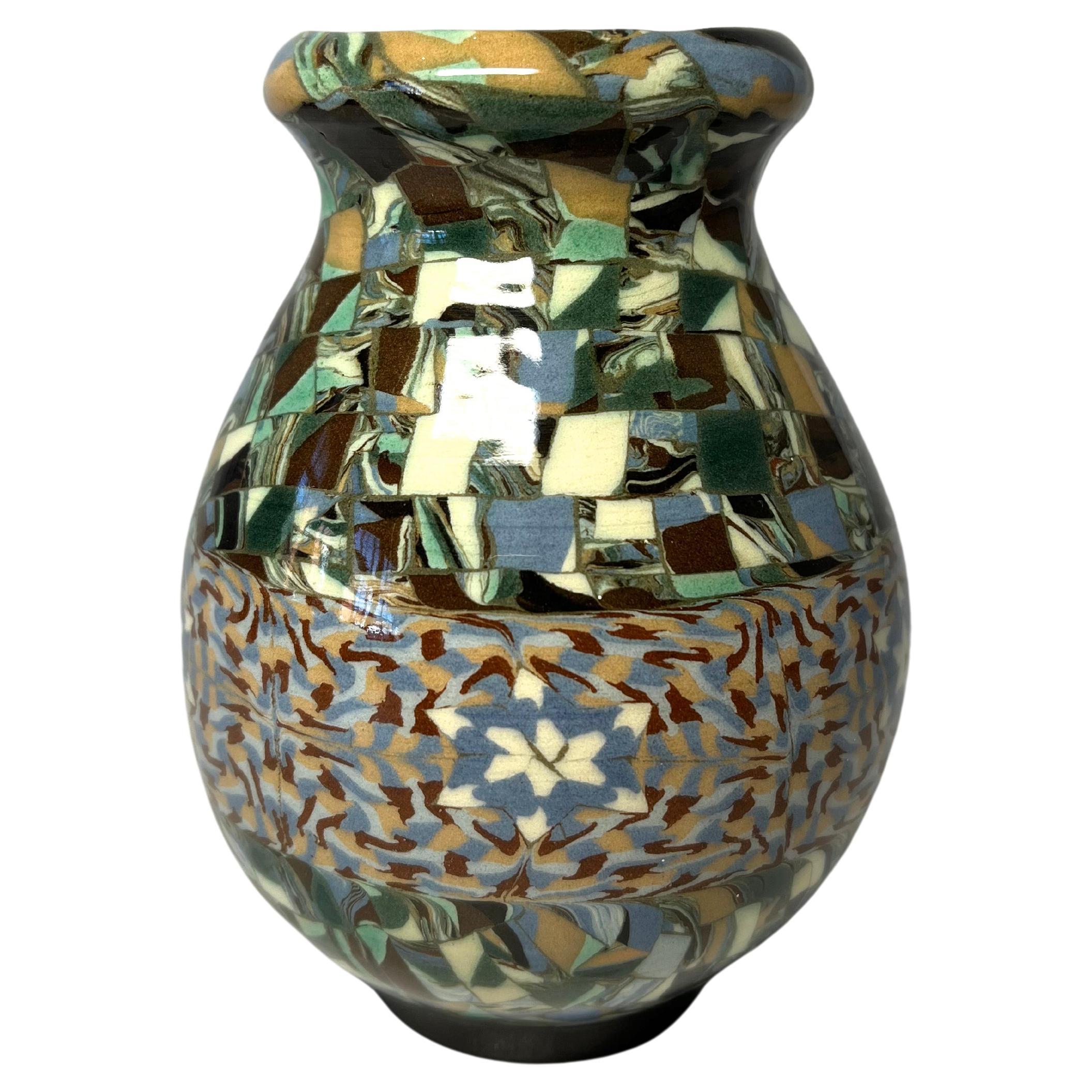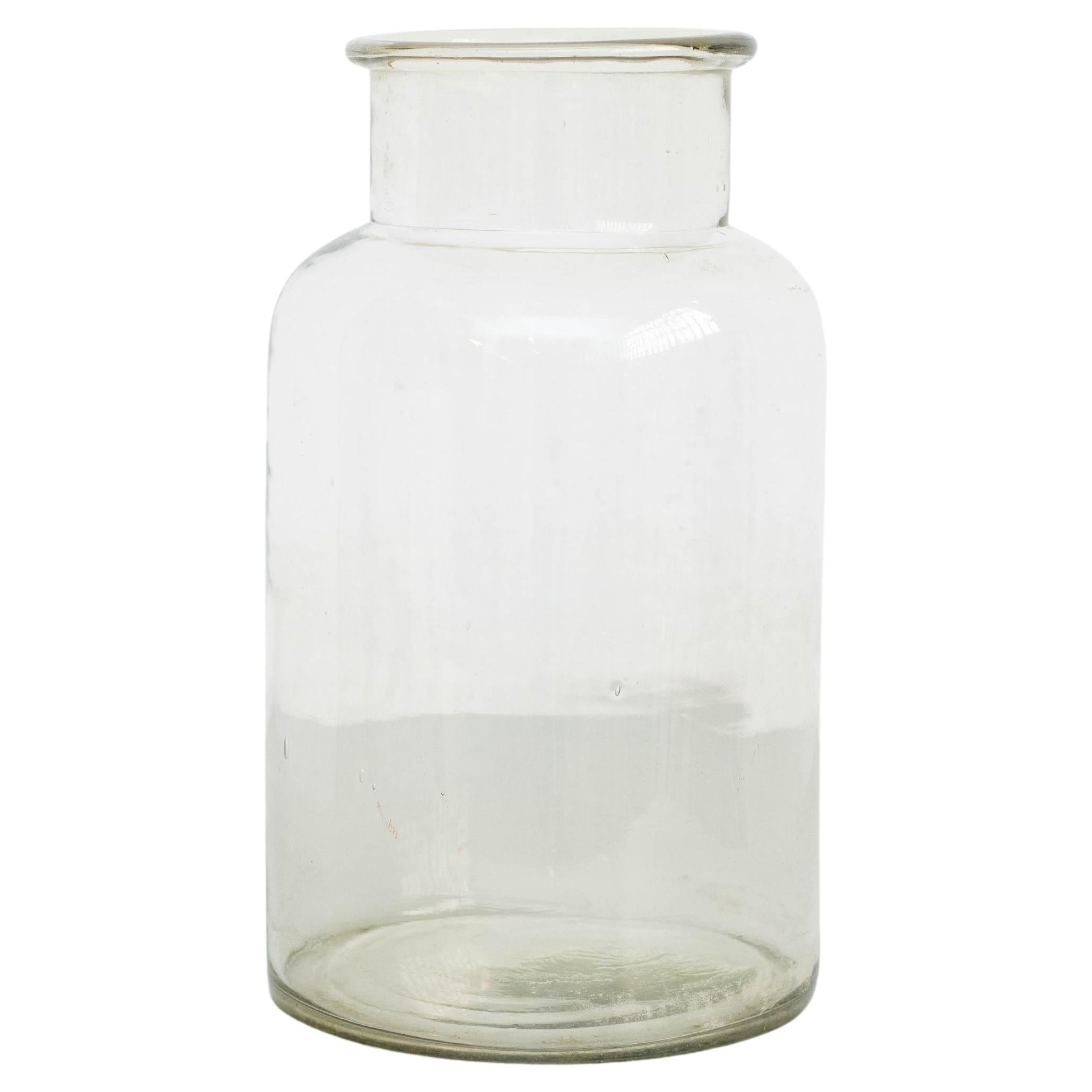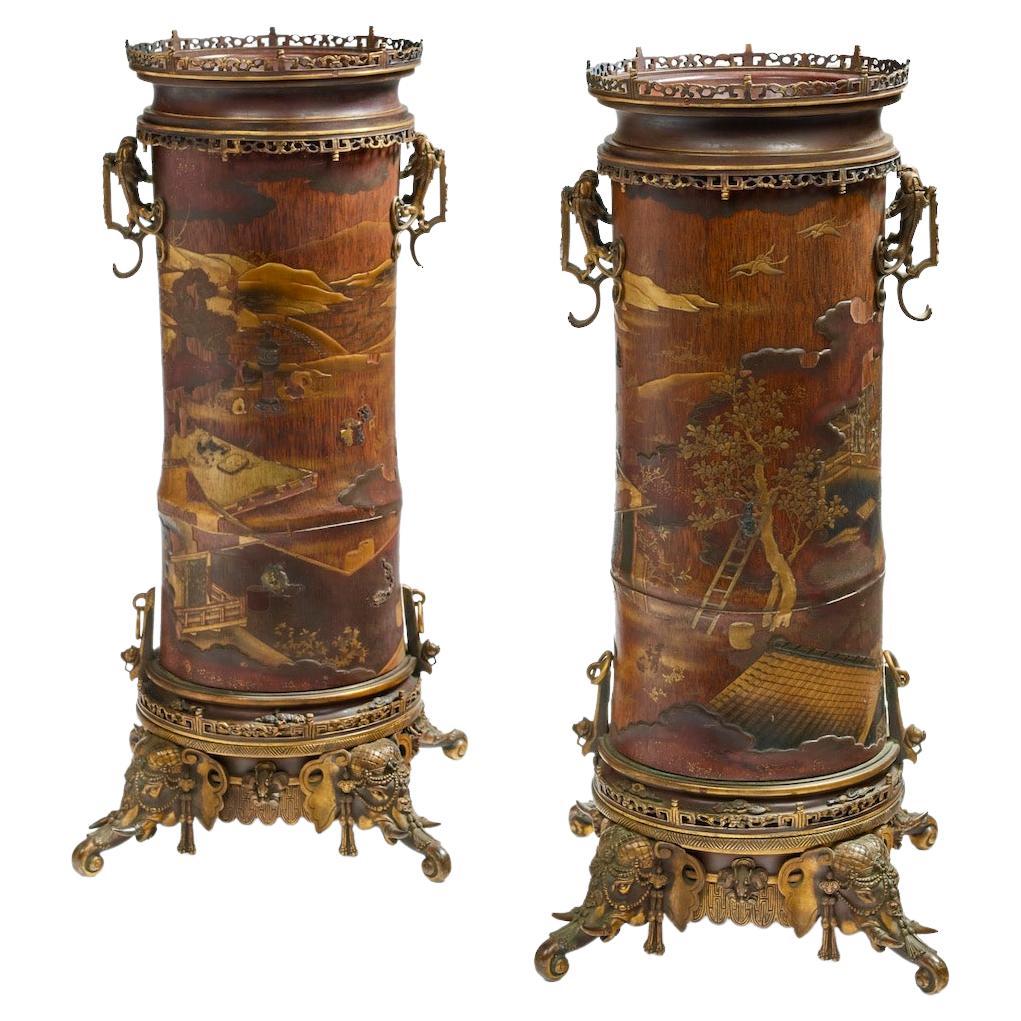Items Similar to Theodore Deck '1823-1891', a Japonisme Polychromed Faience Quadrangular Vase
Want more images or videos?
Request additional images or videos from the seller
1 of 13
Theodore Deck '1823-1891', a Japonisme Polychromed Faience Quadrangular Vase
About the Item
Theodore Deck (1823-1891)
A Polychromed Faience quadrangular vase, decorated in a cartouche with butterfly and birds on branches of prunus and peonies in the Japanese Taste on a purple background of foliage and flowers, the base with Greek friezes and leaves.
Impressed TH.DECK mark under the base.
circa 1870.
Joseph-Théodore Deck was born in 1823 in Guebwiller in Alsace.He dreamed to become a sculptor but his humble origins oriented him towards a more prosaic profession: ceramic potter. He learned the technique of ceramics as a manufacturer of covered ovens with ceramic tiles and traveled to Germany, Hungary and Austria to improve his skills. At the age of 24, he moved to Paris to practice his art and worked in a factory that made ceramic kilns. He opened his own earthenware workshop in 1856 with his brother and his nephew and specialized in the oriental style and more particularly in the Iznik style. In the 1880s he explored the Chinese tradition and collaborated with Raphaël Collin, an academic painter professor at the Academy of Fine Arts recognized for the links he forged between French art and Japanese art both in painting. and ceramic. He published a treatise on the art of earthenware in 1887.He died in Paris in 1891.
Deck's contemporary sculptors and painters made frequent visits to the Deck workshop, which thus became an experimental laboratory to promote ceramics as an art and no longer simply as an industrial application. It was while attending the National Porcelain Museum in Sèvres that Deck studied Islamic art. Deck discovered that the brilliance of oriental ceramics was due to an alkaline base containing tin oxide. The decorations are covered with a transparent coating which produces a shiny and translucent effect. After many trials and experiments, Deck succeeded in perfecting this technique and created Deck Blue, his famous turquoise-blue using potash, soda ash and chalk. Deck presented his first collection of louvered earthenware at the Paris Exhibition of 1861 but it was at the London Exhibition of 1862 that he was officially recognized as an artist when the Victoria and Albert Museum bought three of his works. . He received a silver medal at the Universal Exhibition of 1867. Deck copied many Iznik ceramics but also created his own variations around the oriental theme by assembling various patterns on a single work.
- Creator:Theodore Deck (Maker)
- Dimensions:Height: 18.9 in (48 cm)Width: 9.45 in (24 cm)Depth: 8.67 in (22 cm)
- Style:Japonisme (Of the Period)
- Materials and Techniques:Faience,Enameled
- Place of Origin:
- Period:
- Date of Manufacture:circa 1870
- Condition:Wear consistent with age and use.
- Seller Location:Saint-Ouen, FR
- Reference Number:1stDibs: LU2612316755321
About the Seller
4.9
Vetted Seller
These experienced sellers undergo a comprehensive evaluation by our team of in-house experts.
1stDibs seller since 2017
57 sales on 1stDibs
Typical response time: 1 hour
- ShippingRetrieving quote...Ships From: Saint-Ouen, France
- Return PolicyA return for this item may be initiated within 2 days of delivery.
Auctions on 1stDibs
Our timed auctions are an opportunity to bid on extraordinary design. We do not charge a Buyer's Premium and shipping is facilitated by 1stDibs and/or the seller. Plus, all auction purchases are covered by our comprehensive Buyer Protection. Learn More
More From This SellerView All
- Théodore Deck (1823-1891), Miniature Pair of Faience Vases circa 1870By Theodore DeckLocated in Saint-Ouen, FRTheodore Deck (1823-1891) A deep green enameled faience miniature pair of vases molded in the Chinese Archaistic Taste. Coves in the shape of elepha...Category
Antique 1870s French Chinoiserie Vases
MaterialsFaience
- Théodore Deck (1823-1891), an Impressive 19th Century Faïence ChargerBy Theodore DeckLocated in Saint-Ouen, FRThéodore Deck ( 1823-1891) Impressive polychromed circular faience charger with hand-painted enameled design of a wader among water lilies and reeds. Impressed Uppercase Mark Th.Dec...Category
Antique 1870s French Japonisme Ceramics
MaterialsFaience
- Théodore Deck (1823-1891) Faience Paneled Fourteen-Tile Rectangular Wall PlaquBy Theodore DeckLocated in Saint-Ouen, FRA Théodore Deck (1823-1891) Faience Paneled Fourteen-Tile Rectangular Wall Plaque Polychromic Earthenware very finely hand-painted, designed with a couple of pheasants among vegetat...Category
Antique 1870s French Japonisme Decorative Art
MaterialsFaience, Wood
- French 19th Century Pair of Lacquered Bamboos Japonisme VasesBy Edouard Lievre, Ferdinand BarbedienneLocated in Saint-Ouen, FRA 19th French century pair of Lacquered Bamboos Japonisme vases. An amazing pair of tall cylindrical bamboo vases decorated in Japanese Gold and Sil-ver Hiramaki-E Lacquer with Pavilions in The Mist and Weaving Figures, Flown Over by a Pair of Cranes. Enclosed in a Sino-Japanese Inspiration Golden and Brown Patina Bronze Mount Featuring Elephant Heads, Partially Openwork Branches and Salamanders Forming Side Handles. Circa 1870 Attributed to Édouard Lièvre (1828-1886) and Ferdinand Barbedienne (1810-1892) Édouard Lièvre (1828-1886) is one of the most talented and prolific designer and industrialist of the 19th Century, his repertoire is sometimes Sino-Japanese or Neo-Renaissance, whether in furniture or works of art, we can note in particular the parade bed of Valtesse de La Bigne, furniture commissioned by the painter Édouard Detaille or even Sarah Bernhardt, and the famous works in collaboration with Maison Christofle or those in gilded bronze and cloisonné enamel edited by Ferdinand Barbedienne, presented at the Universal Exhibitions in 1878, 1889 and 1900. He was both a draftsman, painter, illustrator, engraver, ornamentalist and cabinetmaker, first trained in the studio of the painter Thomas Couture, Lièvre was then fully immersed in the world of decoration, creation and ornamentation and provides designs for manufacturers and merchant-publishers. Often assisted by his brother Justin, he first produced works of art for his own apartment, seeking out the finest craftsmen to execute his designs for bronzes, ceramics, fabrics and luxury furniture from great virtuosity and great taste. He then collaborated with the cabinet-maker Paul Sormani, as well as haberdasher merchants such as the Escalier de Cristal, bronziers such as Maison Marnyhac and especially Ferdinand Barbedienne as on our vases with bronze mounts characteristics of Edouard Lièvre's work. Born in 1810, died in Paris in 1892, Ferdinand Barbedienne, the most important caster of bronze pieces of art during the second half of the 19th Century, created and directed in Par-is one of the major artistic foundries of his time. Barbedienne specialized in classical reproductions, whose models were exposed in famous European museums. Their illustrated catalogues included many diverse objects such as busts, ornemental sculpture (clocks, candelabras, cups) sometimes even life-sized and bronzes for furniture. Apart from his own produc-tion, Barbedienne worked for the most renowned sculptors such as Barrias, Clésinger and Carrier-Belleuse. All his works were highly esteemed and he, himself honored by contemporary critics. At the London exhibition in 1851 Barbedienne’s firm won two « Council medals ». At the 1855 Universal Exhibition, he won a medal of honor. The success of Barbedienne’s firm brought him many official commissions, such in about 1860, as Barbedienne supplied bronzes for furniture for the Pompeian Villa of Prince Napoléon-Joseph, located avenue Montaigne in Paris. At the London Universal Exhibition of 1862 Barbedienne won medals in three different categories: Furniture, Silversmith work and Artistic bronzes. Barbedienne was made an officer of the Légion d’Honneur in 1867 and Commander in 1878 when he was compared with « a prince of industry and the king of bronze casting ». His glory did not decline with the passage of the time for at the Universal Exhibition of 1889 the critics thanked Barbedienne for the example he set for other bronze-casters by the perfection of his bronzes. “Japonisme” in the second half of the 19th century, was a craze for everything that came from Japan or imitated its style. The word was first coined in a series of articles published by Philippe Burty, from May 1872 to February 1873, in the French magazine “la Renaissance Littéraire et Artistique”. Far from the Academic sphere, artists seeking for new ways of expression, appropriated this discovery. Manet and the impressionists led the way to half a century of enthusiasm for Japanese art, and largely contributed to the esthetical revolution Europe experienced between 1860 and the beginning of the twentieth century. From 1862, The World’s Fairs provoked massive arrivals of fans, kimonos, lacquers, bronzes, silks, prints and books that launched the real era of Japonisme. With those exhibitions, the demand was boosted, the number of merchants and collectors was multiplied, and artists became passionate about this new esthetic. For them, its “primitivism” was probably its most important quality: artists were fond of the Japanese art’s capacity to be close to nature and to reconcile art and society by representing, with a lot of care, the most trivial objects. In painting, Edouard Manet, Mary Cassatt, Degas, Van Gogh, Gauguin were among those who were deeply inspired by Japanese art, affected by the lack of perspective and shadow, the flat areas of strong color, the compositional freedom in placing the subject off-center, with mostly low diagonal axes to the background. The Japanese iris, peonies, bamboos, kimonos, calligraphy, fish, butterflies and other insects, the blackbirds, cranes and wading birds, the cats, tigers, and dragons were endless sources of inspiration, appropriation, and reinterpretation for European artists. The occidental productions were combining styles and artistic conceptions instead of copying Japanese art slavishly. That is what brings to light the comparison between the artworks of Kitagawa Utamaro and Degas, of Katsushika Hokusai and Van Gogh The World’s Fairs of 1851 and 1862 in London, those of 1867, 1878, 1889 and 1900 in Paris, of 1873 in Vienna and of 1904 in Saint Louis presented a number of “Japanese-Chinese” installations with earthenware, bronzes, screens and paintings and attracted the largest amounts of visitors In Vienna, the “Japanese village...Category
Antique 1870s French Japonisme Vases
MaterialsBronze
- French Japonisme Lacquered Metal Jardinière on Ormolu Stand Signed MarnyhacBy Edouard Lievre, Maison Marnyhac 1Located in Saint-Ouen, FRJardinière Médicis vase shape in copper with gold lacquered decoration on a burgundy background of a Japanese landscape with a volcano and an eagle ...Category
Antique 1870s French Japonisme Planters, Cachepots and Jardinières
MaterialsMetal, Bronze
- Pair of Porcelain Vases Ormolu-Mounted in Lamps by Gagneau Paris XIXth CenturyBy Gagneau ParisLocated in Saint-Ouen, FRPair of large Japanese Porcelain Cone Shape Vases with Imari decoration Important mounts in ormolu and gilded metal, the base decorated with a laurel wreath, the upper part of falling leaves and a frieze of knotted ribbon. The mounts signed Gagneau, 115 R. Lafayette. Circa 1860 With their original aluminium bulb cover and original gilding Vase it self Height 47 cm The Gagneau Company is one of the most famous lighting factories in Paris in the nine-teenth century, established in 1800 at 25 rue d'Enghien in Paris and later at 115 rue de Lafayette. She has participated in many exhibitions throughout this century. She began in 1819 with the Exposition des Produits de l'Industrie and later participated in the Universal Exhibitions where she was part of the jury in the category of art bronzes (class 25) at the Universal Exhibition in Paris in 1889. "Imari" was simply the trans-shipment port for Arita wares, from where they went to the for-eign trading outposts at Nagasaki. It was the kilns at Arita which formed the heart of the Japanese porcelain industry. Arita's kilns were set up in the 17th century, after kaolin was discovered in 1616. A popular legend attributes the discovery to an immigrant Korean potter, Yi Sam-Pyeong (1579–1655), although most historians consider this doubtful. After the discovery, some kilns began to produce revised Korean-style blue and white porcelains, known as Early Imari, or "Shoki-Imari". In the mid-17th century, there were also many Chinese refugees in northern Kyushu due to the turmoil in China, and it is said that one of them brought the overglaze enamel coloring technique to Arita. Thus Shoki-Imari developed into Ko-Kutani, Imari, and later Kakiemon, which are sometimes taken as a wider group of Imari wares. Ko-Kutani was produced around 1650 for both export and domestic market.Kutani Ware is characterized by vivid green, blue, purple, yellow and red colors in bold designs of landscapes and nature. Blue and white porcelain pieces continued to be produced and they are called Ai-Kutani. Ko-Kutani Imari for the export market usually adopted Chinese design structure such as kraak style, whereas Ai-Kutani for the domestic market were highly unique in design and are ac-cordingly valued very much among collectors. Ko-Kutani style evolved into Kakiemon-style Imari, which was produced for about 50 years around 1700. Kakiemon was characterized by crisp lines, and bright blue, red and green designs of dramatically stylized floral and bird scenes. Imari achieved its technical and aes-thetic peak in the Kakiemon style, and it dominated the European market. Blue and white Kakiemon is called Ai-Kakiemon. The Kakiemon style transformed into Kinrande in the 18th century, using underglaze blue and overglaze red and gold enamels, and later additional colors. Imari began to be exported to Europe when the Chinese kilns at Jingdezhen were damaged in the political chaos and the new Qing dynasty government halted trade in 1656–1684. Ex-ports to Europe were made through the Dutch East India Company, and in Europe the des-ignation "Imari porcelain" connotes Arita wares of mostly Kinrande Imari. Export of Imari to Europe stopped in mid-18th century when China resumed export to Europe, since Imari was not able to compete against Chinese products due to high labor costs. By that time, however, both Imari and Kakiemon styles were already so popular among Eu-ropeans that the Chinese export porcelain copied both, a type known as Chinese Imari. At the same time, European kilns, such as Meissen and English potteries such as Johnson Bros. and (Royal) Crown Derby, also imitated the Imari and Kakiemon styles. Export of Imari surged again in late 19th century (Meiji era) when Japonism flourished in Europe.Thus, in the western world today, two kinds of true Japanese Imari can...Category
Antique 1880s French Japonisme Table Lamps
MaterialsBronze
You May Also Like
- Pair of Theodore Deck VasesBy Theodore DeckLocated in Saverne, Grand EstExtremely rare pair of Gu-shaped turquoise enamelled ceramic vases, carried by elephants and resting on an openwork base ending in four flared feet. Some lack of enamel otherwise ver...Category
Antique 1880s French Japonisme Vases
MaterialsCeramic
- Pair of Ormolu-Mounted Theodore Deck Faience Persian-Blue Vases with LampshadesBy Theodore DeckLocated in Palm Desert, CAA pair of late 19th century ormolu-mounted faience Persian-blue vases by Theodore Deck, mounted as oil lamps. As in traditional Persian design, the lamps are bottle-shaped, with a wi...Category
Antique 19th Century French Vases
MaterialsOrmolu
- Théodore Deck, Ceramic Vase, Signed, circa 1870By Theodore DeckLocated in Saint-Ouen, FRThéodore Deck (1823-1891), ceramic vase, signed, circa 1870.Category
Antique Late 19th Century French Art Nouveau Ceramics
MaterialsCeramic
- Large Theodore Deck Earthenware Bottle Form Vase in the Islamic/Iznik TasteBy Theodore DeckLocated in New York, NYA large and impressive Theodore Deck Earthenware bottle form vase in the Islamic/Iznik Taste, Impressed "TD" 1870 on the bottom. The narrow circular neck is decorated with dark blue,...Category
Antique 1870s French Islamic Vases
MaterialsPorcelain
- Pair of Gilt Bronze Mounted Faience Lamps by DeckBy Theodore Deck, Gagneau FrèresLocated in London, GBThese beautiful table lamps are by Théodore deck, one of the most important ceramicists of the 19th Century, and Gagneau Frères, a leading bronzier. Deck was the director of a presti...Category
Antique Late 19th Century French Vases
MaterialsOrmolu, Bronze
- 19th Century Delft Polychrome Faience VaseLocated in Winter Park, FLA 19th century delft faience polychrome painted vase with round body and narrow neck ending in an open bulb. Beautifully decorated in blue, orange, brown and green with large medalli...Category
Antique 19th Century Dutch Chinoiserie Delft and Faience
MaterialsFaience
Recently Viewed
View AllMore Ways To Browse
Polychrome Vase
19th Century Japonisme
Covered Vase China
Chineses Vases And Covers
Chinese Vase And Cover
Chinese Covered Vase
Polychrome Enameled Vases
Peony Vase
Enamel Tile
Enameled Tile
Polychrome Bird
French Faience Vase
Vases Frieze
Faience Vases Blue
Greek Frieze
Antique Chinese Vase Marks
Antique Oriental Vase Vases
Oriental Vase Antique





